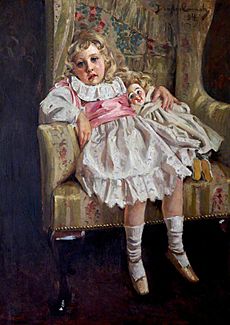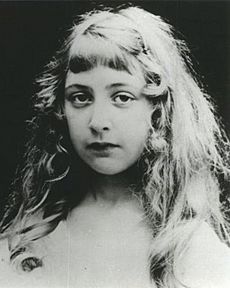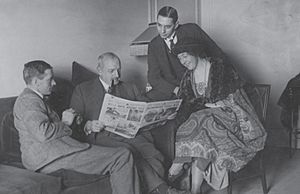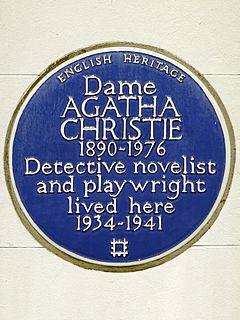Agatha Christie facts for kids
Quick facts for kids
Agatha Christie
|
|
|---|---|
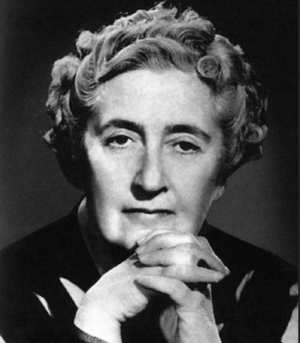
Christie in 1958
|
|
| Born | Agatha Mary Clarissa Miller 15 September 1890 Torquay, Devon, England |
| Died | 12 January 1976 (aged 85) Winterbrook House, Wallingford, Oxfordshire, England |
| Resting place | Church of St Mary, Cholsey, Oxfordshire |
| Pen name | Mary Westmacott |
| Occupation |
|
| Genre |
|
| Literary movement | Golden Age of Detective Fiction |
| Notable works |
|
| Spouses |
Archibald Christie
(m. 1914; div. 1928)Max Mallowan
(m. 1930) |
| Children | Rosalind Hicks |
| Relatives | James Watts (nephew) |
| Signature | |
Dame Agatha Mary Clarissa Christie (born Miller; 15 September 1890 – 12 January 1976) was a famous English writer. She is best known for her 66 detective novels and 14 short story collections. She also wrote The Mousetrap, the world's longest-running play.
Christie is often called the "Queen of Crime" because of her popular mystery stories. She also wrote six novels under the name Mary Westmacott. In 1971, she was given the title of Dame by Queen Elizabeth II. This was to honor her great contributions to literature.
Guinness World Records lists Christie as the best-selling fiction writer ever. Her books have sold more than two billion copies around the world. Her novel And Then There Were None is one of the top-selling books of all time.
Christie was born into a wealthy family in Torquay, England. She was mostly taught at home. She worked in hospital pharmacies during both World Wars. This helped her learn about poisons, which she used in many of her stories.
Contents
Life and Writing Career
Early Life and Education
Agatha Mary Clarissa Miller was born on 15 September 1890. She was the youngest of three children. Her parents were Frederick Alvah Miller and Clarissa Margaret "Clara" Miller.
Agatha described her childhood as "very happy." She spent a year abroad with her family in France and other places. Because her brother and sister were much older, she often played alone. She made up imaginary friends and played with her pets.
Agatha's mother believed she should not learn to read until she was eight. But Agatha was very curious and learned to read by age four. Her parents and sister taught her at home. She learned reading, writing, and basic math. She also learned to play the piano and mandolin.
Agatha loved to read from a young age. She enjoyed children's books and later works by famous authors like Charles Dickens. When she was 10, she wrote her first poem.
Her father died in November 1901 when Agatha was 11. She later said this marked the end of her childhood. After his death, the family had less money. In 1905, her mother sent her to Paris to study music. She wanted to be a concert pianist or opera singer. However, she decided she did not have the talent for it.
First Marriage and First Books
After finishing her education, Christie returned to England. She spent time in Egypt with her mother. She enjoyed social events and watching polo matches. When she was 18, she wrote her first short story. It was called "The House of Beauty."
She also started her first novel, Snow Upon the Desert. She sent it to six publishers, but they all said no. Her mother suggested she ask for advice from a family friend, the novelist Eden Phillpotts. He encouraged her writing.
In October 1912, she met Archibald "Archie" Christie at a dance. He was a Royal Artillery officer. They quickly fell in love and got engaged three months later.
When World War I began in August 1914, Archie was sent to France. They married on Christmas Eve 1914. During the war, Christie worked as a nurse. She also worked as a dispenser, preparing medicines. This gave her knowledge of poisons, which she used in her books.
Christie had always loved detective novels. She wrote her first detective novel, The Mysterious Affair at Styles, in 1916. It introduced Hercule Poirot, a former Belgian police officer. She got the idea for Poirot from Belgian refugees in Torquay. The book was published in 1920.
Christie gave birth to her only child, Rosalind, in August 1919. Her second novel, The Secret Adversary (1922), featured new detectives, Tommy and Tuppence. She was now able to sell her work easily.
In 1922, the Christies went on a world tour to promote the British Empire Exhibition. They traveled to South Africa, Australia, New Zealand, Hawaii, and Canada. They even learned to surf standing up in Hawaii.
A Brief Disappearance
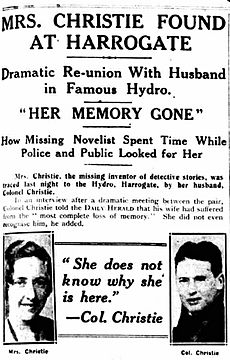
In 1926, Christie's mother died, which made her very sad. Around the same time, her husband Archie asked for a divorce. He had fallen in love with another woman.
One evening in August 1926, Christie disappeared from her home. Her car was found empty near a chalk quarry. Her disappearance became a huge news story. More than a thousand police officers and many volunteers searched for her. Even Arthur Conan Doyle, the creator of Sherlock Holmes, tried to help find her.
After 11 days, she was found at a hotel in Harrogate, Yorkshire. She did not remember what had happened. People still wonder about the exact reasons for her disappearance. Christie never wrote about it in her autobiography.
Second Marriage and Later Life
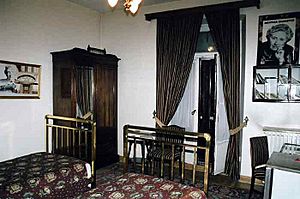
Christie divorced Archie in 1928. She kept her writing name, Agatha Christie. In 1928, she traveled to Istanbul and Baghdad. In Iraq, she met archaeologist Max Mallowan. He was 13 years younger than her.
Christie and Mallowan married in September 1930. Their marriage lasted until Christie's death in 1976. She often joined Max on his archaeological trips. Her travels gave her ideas for many novels set in the Middle East. For example, her 1934 novel Murder on the Orient Express was inspired by her train journeys.
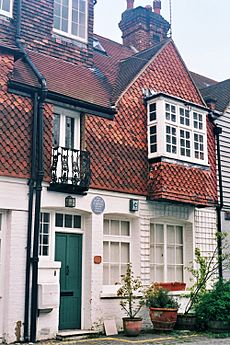
Christie and Mallowan lived in London and later bought Winterbrook House in Oxfordshire. This became their main home. Christie did much of her writing there. She also owned the Greenway Estate in Devon as a summer home.
During World War II, Christie worked in a hospital pharmacy in London. She updated her knowledge of poisons there. Her novel The Pale Horse was based on a suggestion from the chief pharmacist.
The British intelligence agency MI5 even investigated Christie once. This was because a character named Major Bletchley appeared in her 1941 thriller N or M?. MI5 worried she had a spy in the secret codebreaking center, Bletchley Park. But Christie explained she just used the name because she was stuck at Bletchley train station.
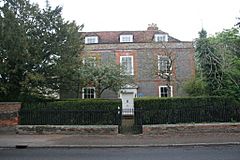
In 1971, she was made a Dame Commander of the Order of the British Empire (DBE). This is a very high honor in Britain. Her health began to fail from 1971 to 1974. Her last novel was Postern of Fate in 1973.
Personal Qualities
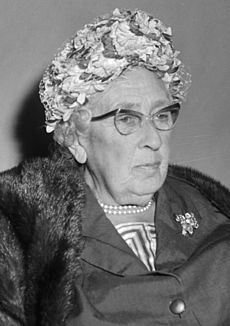
Christie once said she disliked crowds, loud noises, and cinemas. She also disliked the taste of alcohol and smoking. She loved sun, sea, flowers, and traveling. She enjoyed sports, concerts, and doing embroidery.
She was a shy person and did not like public appearances. But people found her friendly and witty. She belonged to the English upper middle class. She wrote about people like herself, which was part of her charm.
Death and Legacy
Death and Burial
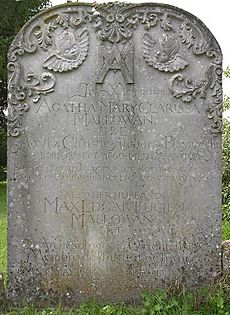
Agatha Christie died peacefully on 12 January 1976. She was 85 years old. She died from natural causes at her home, Winterbrook House.
Two West End theaters in London dimmed their lights to honor her. She was buried in the churchyard of St Mary's, Cholsey. This was a spot she had chosen with her husband years before. Many wreaths were placed on her grave.
Max Mallowan, her husband, died in 1978. He was buried next to Christie.
Her Estate and Works
Christie set up a company in 1955 called Agatha Christie Limited. This company holds the rights to her works. In 1968, she sold a large part of this company.
Agatha Christie Limited still owns the rights to over 80 of her novels and short stories. It also owns rights to 19 plays and nearly 40 TV films. Christie sold an estimated 300 million books during her lifetime. She was the best-selling novelist in history when she died.
Her family still owns a part of Agatha Christie Limited. They continue to be involved with the company. Her grandson, Mathew Prichard, donated her summer home, Greenway Estate, to the National Trust.
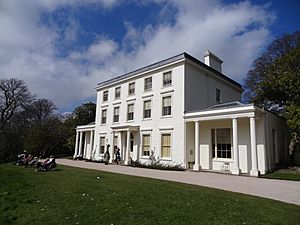
Christie's works are still being adapted today. The BBC acquired the TV rights to her works in the UK in 2014. They have broadcast new productions for her anniversaries.
Her Famous Works
Hercule Poirot and Miss Marple
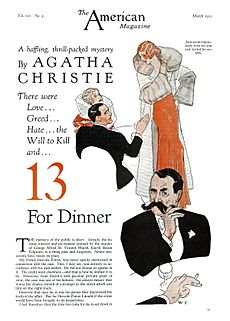
Christie's first published book, The Mysterious Affair at Styles (1920), introduced Hercule Poirot. He appeared in 33 of her novels and over 50 short stories. Poirot is a former Belgian police officer. He is known for his "magnificent moustaches" and egg-shaped head.
Christie sometimes grew tired of Poirot. But she protected him strongly against any wrong ideas about his character. She never killed him off while he was still popular.
Miss Jane Marple was introduced in short stories starting in 1927. These stories were later collected in The Thirteen Problems. Miss Marple is an elderly, gentle spinster. She solves crimes by comparing them to life in her English village. Christie said Miss Marple was inspired by her own step-grandmother. Miss Marple appeared in 12 novels and 20 stories.
During World War II, Christie wrote two novels featuring Poirot and Miss Marple. These were Curtain and Sleeping Murder. She put them in a bank vault to be published later. Curtain was published in 1975, and Sleeping Murder was published after her death in 1976.
Poirot became the first fictional character to have an obituary in The New York Times. This happened on 6 August 1975, shortly before Curtain was published. Christie never wrote a story with both Poirot and Miss Marple together. She said Poirot, being an egoist, would not like an elderly lady telling him how to do his job.
In 2013, the Christie family supported a new Poirot story. It was called The Monogram Murders and written by Sophie Hannah. Hannah has written three more Poirot mysteries since then.
Her Writing Style
Christie is known for her clever plots. She has been called the "Duchess of Death" and the "Queen of Crime." A reporter once said her plots were "possible, logical, and always new."
She would often make the least likely character the guilty one. She even joked about this in one of her books. She would first create characters and a setting. Then she would plan out scenes where clues would be revealed.
In 2013, crime writers voted The Murder of Roger Ackroyd as the "best whodunit ever written." In 2015, And Then There Were None was named the "World's Favourite Christie."
Writing as Mary Westmacott
Christie published six other novels under the name Mary Westmacott. This allowed her to write different kinds of stories. These books often received better reviews than her detective novels.
Her first book as Mary Westmacott was Giant's Bread (1930). The identity of "Mary Westmacott" was kept secret for a long time. It was revealed by a journalist in 1949. After that, she wrote two more books under that name.
Non-Fiction Works
Christie wrote a few non-fiction books. Come, Tell Me How You Live is about her experiences on archaeological digs. The Grand Tour is a collection of letters from her 1922 world tour. Her autobiography, Agatha Christie: An Autobiography, was published after her death in 1977.
Adaptations of Her Work

Many of Christie's works have been made into films and TV shows. The first film was The Passing of Mr. Quin in 1928. Poirot first appeared in a film in 1931.
Margaret Rutherford played Miss Marple in a series of films in the 1960s. Christie liked her acting but thought the films were not very good. However, she loved the 1974 film Murder on the Orient Express. It had many famous stars.
The TV series Agatha Christie's Poirot (1989–2013) starred David Suchet as Poirot. It ran for 70 episodes. The TV series Miss Marple (1984–1992) adapted all 12 Marple novels. Christie's books have also been adapted for radio, video games, and graphic novels.
Images for kids
See Also
 In Spanish: Agatha Christie para niños
In Spanish: Agatha Christie para niños
- Agatha Awards (literary awards for mystery and crime writers)
- Agatha Christie Award (Japan) (literary award for unpublished mystery novels)
- List of solved missing person cases


